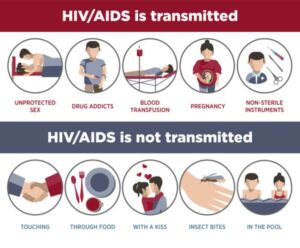A decade of data from South Africa shows AIDS defining cancers are the most common type of cancer, linked with low CD4 counts .
Researchers in South Africa have analysed 10-year’s worth of medical records to shed light on cancer risk among young people with HIV.
Although cancer is rare for young people, what limited evidence exists suggests that young people with HIV are more at risk than their peers.
To help close the evidence gap, the South African HIV Cancer Match (SAM) study linked national HIV and cancer data from adolescents and young people (ages 15–24) collected between 2004 and 2014. It is one of the largest studies to examine cancer among young people with HIV to date.
Of the 782,400 young people with HIV (89% female), 867 developed cancer between the ages of 15 and 24. This is an incidence rate of 60·7 per 100,000 person-years.
The most common cancers were Kaposi sarcoma, non-Hodgkin lymphoma and cervical cancer. When someone with HIV gets one of these illnesses it is a sign that HIV has advanced to AIDS, which is why they are called ‘AIDS defining’. By comparison, the most common types of cancer affecting young people in general are leukaemia, thyroid cancer, and testicular cancer.
The majority (70%) of cancers diagnosed among young people in the study were caused by viruses, such as human papillomavirus (HPV).
Kaposi sarcoma was by far the most common cancer, with an incidence rate of 30 per 100,000 person-years. This is likely to be due to the low number of young people with HIV who were on antiretroviral treatment (ART) between 2004 and 2014 because ART greatly reduces the risk of developing Kaposi sarcoma. Indeed, the study found that young people’s risk of developing cancer was lower between 2012 and 2014, when ART was more available, than between 2004 and 2007 when access was minimal.
After Kaposi sarcoma, the most common types of cancer were non-Hodgkin lymphoma (7·5 per 100 000 person-years), Hodgkin lymphoma (3·4 per 100 000 person-years), cervical cancer (3·4 per 100 000 woman-years), and leukaemia (2·2 per 100 000 person-years). All but leukaemia are caused by viral infections.
Young people with lower CD4 cell counts had a higher risk of developing Kaposi sarcoma, cervical cancer, non-Hodgkin lymphoma and Hodgkin lymphoma.
The risk of developing cancer slightly increased with age, with Kaposi sarcoma more common among those aged 20–24 than those aged 15–19.
Young men with HIV had a higher risk of developing cancer than their female counterparts. For example, 16 of 48 young people (33%) with Hodgkin lymphoma and 12 of 32 (38%) with leukaemia were male. Data on transgender and gender non-conforming people was not recorded.
HPV vaccination for adolescents is now one of the main ways to prevent cervical cancer. South Africa began its national HPV vaccination, which targeted school-aged girls, in 2014. This means most of the young people included in this study would not have been vaccinated against HPV.
Increasing the number of adolescents who get the HPV vaccination is a vital step towards decreasing cervical cancer and other HPV-related cancers among young people with HIV. Research is also needed to assess whether cervical cancer screening should be offered to young people with HIV, who currently need to be older to qualify.
Using innovative, proven strategies to support young people with HIV to access ART and keep taking their medication is essential for reducing their risk of cancer and other illnesses. This is likely to include peer-led strategies to address mental health issues and HIV-related stigma.
Via: Avert



